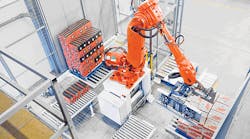Warehouses, which are growing in numbers, should be a source of jobs.
But that’s not happening in California. Warehouses have been a bright spot for lower-skilled Californians. But hiring leveled off in 2016, even though new warehouses kept coming online, according to Natalie Kitroe of the LA Times.
“The modern warehouse tends to be creating fewer jobs…. Automation is replacing the lowest-end jobs,” Chris Thornberg, a founding partner at Beacon Economics, a Los Angeles consulting firm, told Kitroe.
Robots are muscling their way into almost every single occupation, but they pose a direct and immediate threat to people working in storage, industry experts say.
Kitroe cites the example of footwear and apparel manufacturer Skechers, which built a large distribution center in Morono Valley, Calif. with the intention of creating a lot of jobs.
Instead, by the time the company moved to the Moreno Valley, it had closed five facilities in Ontario that employed 1,200 people and cut its workforce by more than half. Today, spotting a human on the premises can feel like an accomplishment.
There are now only about 550 people working at one cavernous warehouse, which is about as big as two Staples Centers combined. Many of them sit behind computer screens, monitoring the activities of the facility’s true workhorses: robotic machines.
Read the entire article.



